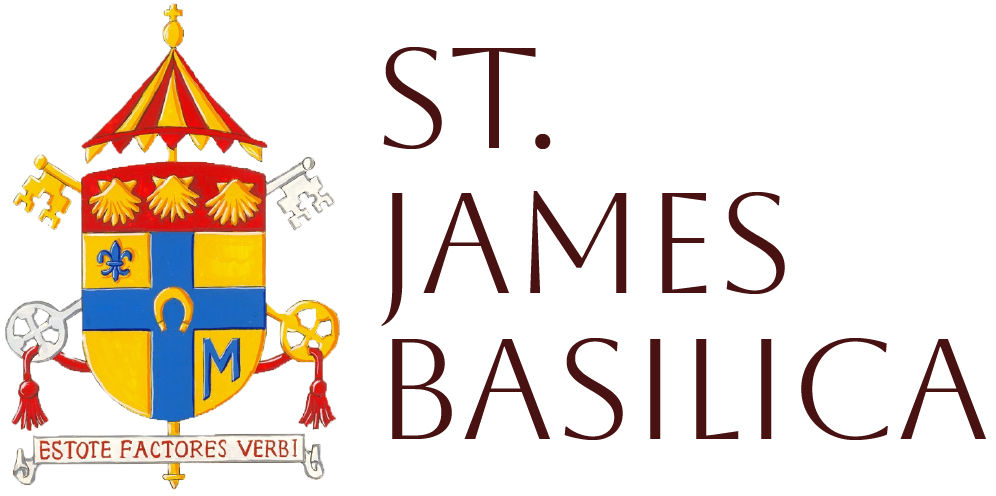About
St. James Basilica History
On October 26, 1988, St. James Church was elevated to the status of a “Minor Basilica” of the Roman Catholic Church, by decree of Pope John Paul II. St. James was the 34 th church in the United States with the designation of Minor Basilica. The elevation service for St. James was held July 23, 1989, with Bishop James S. Sullivan presiding. The Apostolic Brief, designating St. James as a Minor Basilica, is posted in the church, coming in from the southwest entrance, and a plaque with the Papal Emblem, the crossed keys, and date of elevation was attached to the east entrance of the Basilica. “Basilica is a title assigned to certain churches by the Holy See because of their antiquity, dignity, historical importance or significance as centers of worship. St. James is intimately linked to the chair of Peter, which feast is celebrated annually February 22 in solemn fashion. A Basilica is a designated Pilgrim Church, ear marked for special Diocesan events and noted as a center of spiritual renewal for the people of the Diocese. On holy days one or more of the Masses can be said in Latin. Special Masses have been said at the Basilica when a Pope dies or is elected.
The twin towers are 125 feet high. The steeples may be seen towering above the trees and buildings as you enter Jamestown from all directions. The church bell is in the south tower. This is the bell that was made for the original church and is still being used today. The foundation of the church is made of rock faced granite and the main structure is made of Hebron brick, from Hebron, ND. The church is of pure Gothic design throughout. As we enter the church you will see there are eight octagon pillars, four on each side, which support the ceiling. The Gothic arches have indirect lighting which illuminates the arches when the lights are turned on. The church was renovated starting in 1993 to its present décor and was rededicated by Bishop James Sullivan at a rededication Mass on Sunday, February 6, 1994. Bishop Sullivan blessed the Ambo, Altar, Baptismal Font, Tabernacle Chapel, and the new Reconciliation Room. From the front of the church, we look back to the choir loft where we can see the art glass window of St. Cecelia, the patron saint of music, playing her harp. This window had been hidden for many years as the pipes of the old pipe organ were installed across the choir loft thus covering the window. When the pipe organ was rebuilt in 1989, the pipes were arranged in such a way as to leave space so the window could be seen by everyone. The rebuilt organ has 1571 pipes in 26 ranks increasing the sound six fold.
Our windows originally were clear glass which were to be replaced in the future with ornamental stained glass. The art glass windows were installed in 1918. They were made in Minneapolis, Minnesota by Pittsburgh Plate Glass Company. When that branch was closed, records were lost and we have been unable to find out who the artist was. These windows were donated by Pierce Blewett who gave Monsignor Edward Geraghty a check for $5,000. In checking with McMow Art Glass Window Company, the technique used for leaded, stained, art glass is done by mixing crushed glass with a medium, painting it on the glass and then putting it in a kiln where it bakes into the glass.
The windows represent the joyful and glorious mysteries of the rosary. Starting on the south side of the sanctuary is the first joyful mystery, the Annunciation , the next window as you follow the south wall is the Visitation, the five panel windows is the Nativity, the next window is the Presentation, the next window is the Finding of Jesus in the Temple and the last window is Jesus with the Little Children. Moving to the north side of the church, starting at the back are the glorious mysteries. The first window is the Resurrection, moving on is the Ascension, the first two panels of the next window is The Descent of the Holy Spirit on the Apostles. The next three panels is our History Window. The panel on the left is Albert Monek raising the first spade of sod in the ground breaking of the original church in 1881, the second panel is Anton Klaus, Sr. tendering the deed to the church property to a priest and the third panel commemorates the dedication of the church. Moving on to the left we have the Assumption and in the sanctuary we have the last glorious mystery, the Crowning of Mary Queen of Heaven. The Stations of the Cross are either side of the windows, thus making up the 15 mysteries of the rosary.
During the renovation of the church in 1993, the confessional was replaced with a reconciliation room. This can be seen at the back of the church on the north side. The last art glass window is located in this reconciliation room. It is a picture of the Rich Young Man who came to Jesus wanting to know what he had to do to share everlasting life. He had kept the commandments since childhood, then Jesussaid there is one thing more you must do, go sell what you have and give to the poor; you will then have treasure in heaven. After that come follow me. After these words the man’s face fell. He walked away sad as he had many possessions. This is unique as who would have thought when these windows were put in that this window would one day be in the reconciliation room.



